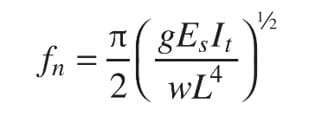Ma.ahmed said:
please note that the applied loads are required as per client/consultant. requiremements and as per porject specifications
as there are finished and slab covering and MEP, so these loads are required.
The project specifications say you must use a superimposed dead load of 3 kN/m2 in the vibration analysis? The analysis must be run with the superimposed dead load that will probably be there during a vibration event, not one that has been set for strength/deflection design.
Ma.ahmed said:
but if i did camber to main beam under dead loads of steel members, Can i use the resultant deflection into calculation so natural frequency EQ3.3
No, camber won't make any difference in the natural frequency. The system will vibrate about an equilibrium position that is higher than if the beam wasn't cambered. That has no effect on frequency or acceleration.
Note that the presence of Delta in the natural frequency equation is only an algebraic manipulation to make the frequency equation easier to remember. The natural frequency of a beam or girder is computed using the following equation, which is from Design Guide 11 Chapter 3.
w/
g is the distributed mass that would be present during vibration. The use of Delta causes never-ending confusion such as this question on camber.
[quote="If you consider a group of five 190 lb average adult males vandal jumping, the sinusoidal load amplitude would be (1.5)(5)(190 lb). Apply that near the middle of your floor and see what acceleration you predict. Let me know if you need help with this step."
are you mean to add point load for (1.5)(5)(190 lb) to beam mide span and check defelction the calcutate natural frequancy. if not please provide explanation reference][/quote]
I would predict the acceleration due to a vandal jumping group using Design Guide 11 Equation 2-1.
1. Compute the amplitude of the sinusoidal force, P = Q*alpha = (190 lb / person)(5 people)(1.5)
2. Compute the effective weight, W, using Design Guide 11 Chapter 4.
3. Compute the effective mass, M = 0.5W/g, as shown in Equation 2-5 and explained in Allen and Murray (1993), which is cited in Design Guide 11.
4. Set beta equal to whatever you are using for the walking analysis. There aren't enough people to justify the 0.06 in Design Guide 11 Chapter 5.
5. Compute the sinusoidal peak acceleration, ap = P / (2 beta M). This is nothing more than the steady-state acceleration amplitude for a viscously damped SDOF system subjected to a sinusoidal force at resonance.
6. There's no specific tolerance limit. I would start taking this case very seriously if you get over 2%g.

